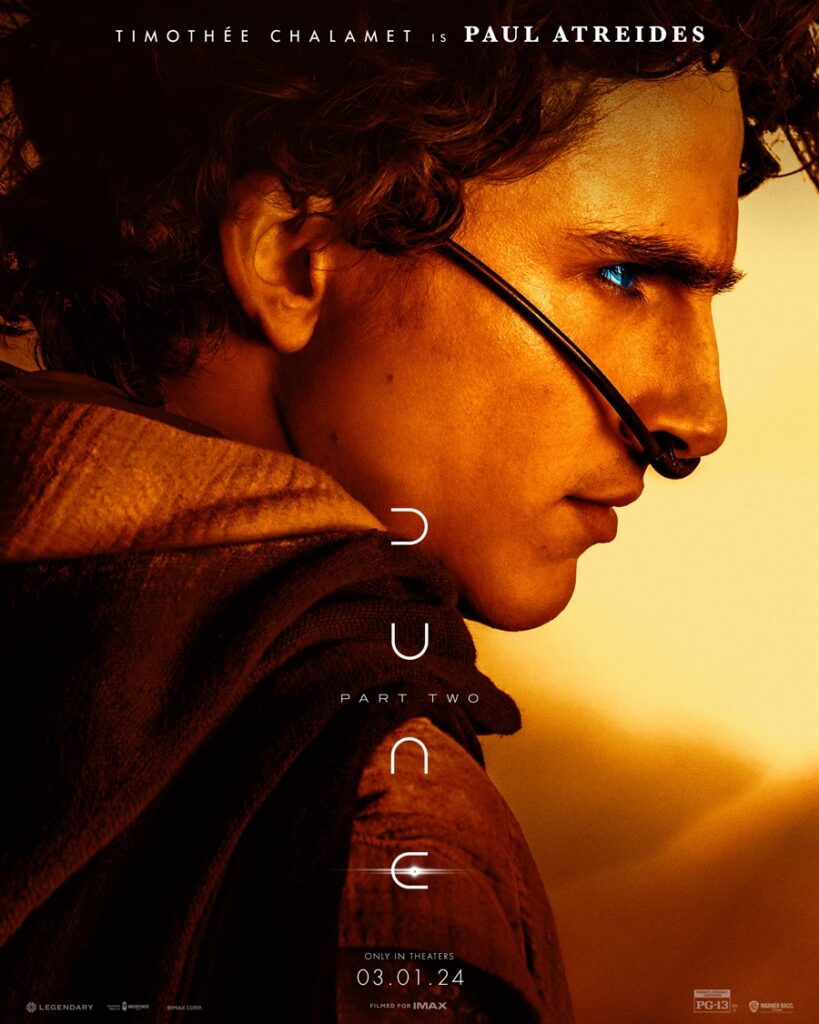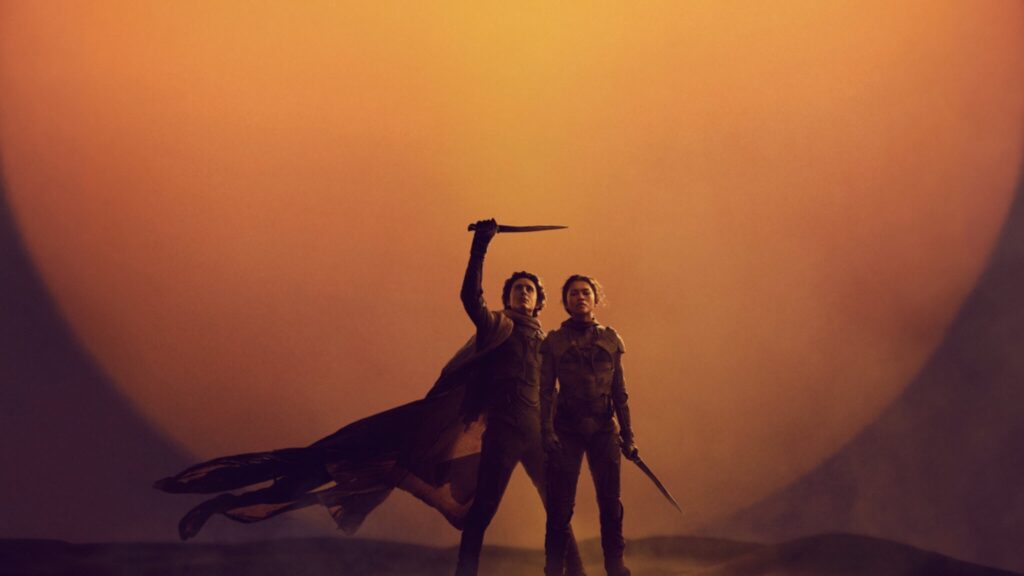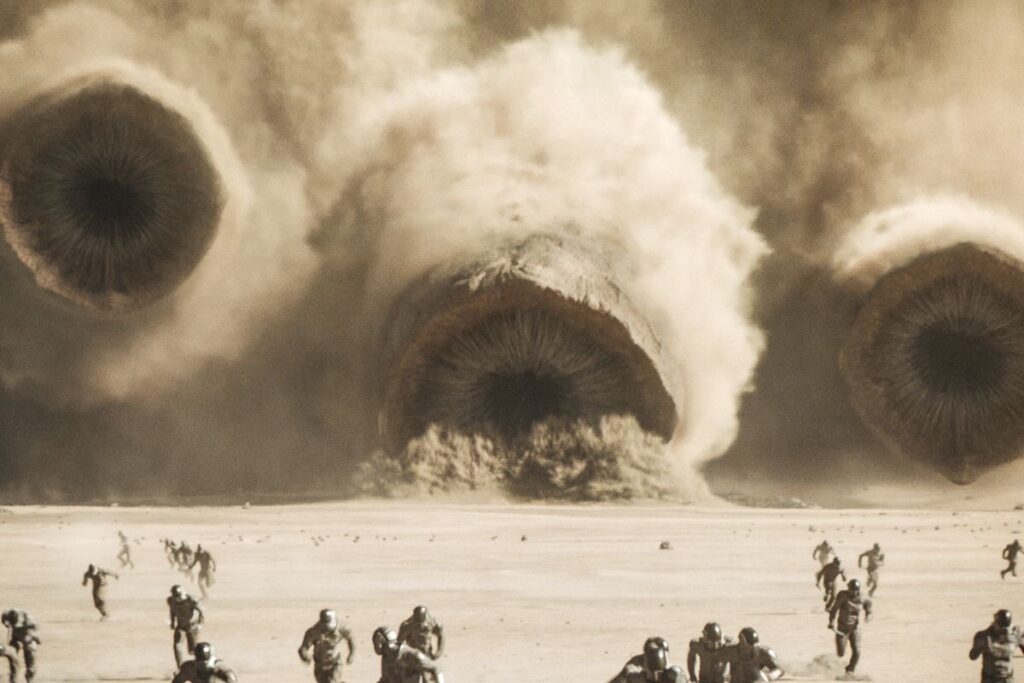Review by Tim Robins
WARNING: SPOILERS AHEAD


Dune: Part Two is the continuation of director Denis Villeneuve’s adaptation of Frank Herbert’s acclaimed novel, Dune, a sprawling tale of a galactic empire built on the protection of spice, a drug that can be used to manipulate time and space and found only on the desert planet Arrakis.
Picking up where Dune: Part One left off, young Paul Atreides (Timothee Chalamet) and his mother, Jessica (Rebecca Ferguson) have been abandoned for dead in the desert by the deeply unpleasant Harkonnens, who are charged with eliminating The House of Atreides on behalf of the galactic Emperor.


To describe Dune: Part Two as eagerly awaited would be an understatement. The film opened on 1st March the United States and immediately earned $12m, more than double the amount Part One earned on release at same time back in 2021. The film has won plaudits from critics, online and off-line. However, don’t be fooled by some of their takes. Many lead you to believe this latest slice of the Dune saga is an action movie. It isn’t. Although there are plenty of action scenes, Villeneuve gives plenty of time and space to world building and focussing on the characters’ hopes, dreams and anxieties. Sure, there are a few more fights but if you found part one a slog, then Part Two, with a running time of two hours 47 minutes could still feel something of a drag.
Dune: Part Two is structured around the challenges Paul Atreides must face in his path to becoming accepted as the prophesied messiah, destined to lead the Fremen of the planet of Arrakis to victory over the Noble Houses that exploit the world for the galactic Emperor. The Fremen’s ultimate goal is to terraform Dune from a desert world to a verdant paradise.
Villeneuve’s film compels you to believe in this alien world where learning to ride gigantic, rampaging sand worms is a rite of passage and Paul’s pregnant mother Jessica has helpful chats with her unborn daughter, awakened in the womb thanks to the hallucinogenic, ‘Water of Life’.
I appreciate all of this could come across as incredibly silly, as did the sight of Baron Harkonnen floating about the place like a helium-filled party balloon, which raised a laugh from the audience and this can only be a nod to David Lynch’s take on Dune (1984), as it is not a feature of Herbert’s book. Neither is the Baron’s oil bath, which I imagine is a nod to the way Herbert explicitly uses Spice as his galaxy’s equivalent of petroleum.

Watching Paul whizz about on the back of a giant worm could also look ludicrous, but Villeneuve wisely chooses close-ups and very long shots to make these scenes incredibly dramatic rather than daft. The director’s eye is often up close. Paul’s eventual triumph over the creature is conveyed in a simple movement, in which Paul’s right leg shifts from being bent and uncertain on a worm’s back, to straight and certain. Paul stands firm and in control of the colossal creature.
The director also channels his passions in fun ways. The silhouette of Paul, cape flowing in the wind, explicitly draws on the image of Tetsuo Shima from Akira (1988). In an interview, Villeneuve has also cited Chuck Jones’s Road Runner cartoons as an influence. That can be seen in a long shot of Paul cartoonishly running along the top of a sand dune to catch up with a sandworm, although the director has said that what influenced him most were the cartoons’ punchiness, and stripped down action.
The sound design also lends credibility. Dune: Part Two is a film that you feel as much as you watch. The base note thundering of the insect-winged Ornithopters actually vibrates the cinema floor. There’s an incredibly tense scene, too, in which Paul and Chani, a Fremen warrior and Paul’s lover, must dodge the spider-like legs of a spice miner, while trying to take one of the droning copters down.
In this sequel, the director replaces his vision of Dune as a chessboard with a rather more Freudian perspective. A ship shaped like a pair of testicles deposits its seed of soldiers on the planet’s surface and the Sandworms at last become more phallic, particularly during the assault on the city of Arrakeen. There may not be a rat taped to a cat that needs to be regularly milked, nor a war pug carried into battle, but we do get weird Harkonen fireworks that burst into oil slicks in the sky. And in place of Sting in outsized, rubber nappy, we get sexual pervert Feyd-Rautha (played by a smoldering Austin Butler), bleached by infrared photography, fighting in an gladiatorial battle with the supposed last of the Atreides.
Dune: Part Two’s success rests on many shoulders, not least those of its scriptwriters, Villeneuve and Jon Spaihts. The dialogue is brief but often delivers a lot of exposition which sets up character motivations and explains how the Dune world works. The plot is convoluted but, unlike recent blockbusters, it has been thoroughly thought through, so twists are understood by the audience and have an impact that similar revelations in other movies lack.
Dune: Part Two even includes three opening narrations – yes, Princess Irulan is back – but this film gets away with it in a way Lynch’s adaptation of Dune didn’t. We are also shown the importance of water for the desert folk, Jessica suffering from morning sickness, who is exhorted not to vomit as the liquid can be collected. Those killed in battle have their water painstakingly extracted to add to a lake the Fremen are creating to terraform their planet.
There is a meme going around that Dune stole from Star Wars, but Dune came first, and it is no surprise that even The Rise of Skywalker’s revelation that Rey is the granddaughter of Palpatine has its roots here. Where Rey’s ancestry was obviously tacked on out of sheer desperation and comes across as ludicrous, the revelations of Atreides’ mixed family background really delivers, demonstrating the convoluted relationships between the characters and adding spice (cough) to the knife fight between Paul and Feyd-Rautha – the Bene Gesserit’s next best hope for the Kwisatz Haderach, a being that will unite male and female collective memories.
Like its predicessor, Dune: Part Two also rests on compelling performances by its cast. Alongside Timothée Chalamet, reprising his role as Paul Atreides, Zendaya returns as Chani, a young Freman. She’s fiercely protective of her people, and sceptical of Paul’s role as the prophesied Messiah, destined to lead the Fremen to victory over their oppressors with the ultimate goal of terra forming Arrakis from an arid desertscape to a verdant paradise. The director never strays far from their developing romance. He loves their faces and placing the characters against a backdrop of sweeping sand dunes. The film moves back and forth from the personal to inter-planetary politics that makes their love seem built on sand.

Javier Bardem steps up as the Freman Stilgar. The whole character carries the burden of belief in Paul as the Freman Messiah. This becomes more than a little tiresome as he interprets everything in terms of the prophecy. But as Paul follows his own path, Stilgar is somewhat comically faced with a lot of mental gymnastics to make Paul’s behaviour fit with destiny. For his part, Paul foresees nothing but disaster until he too imbibes ‘The Water of Life’.
Some mention must go to Christopher Walken who plays the Galactic Emperor, Shaddam IV, in a fright wig that is more off-putting than his accent which sometimes slips into gangster mode. I can suggest reasons Walken was cast. He certainly carries a hint of decrepit menace, his face melting into that of granny as so many of the faces of older people do in the Entertainment industry. The Emperor is a physically weak man and is using the Harkonnen as his weapon of choice. However, there are those that see the influence of Fatboy Slim’s video of Walken dancing to lyrics that include “Walk without rhythm and it won’t attract the worm” and, less obviously, “Don’t be shocked by the tone of my voice, Check out my new weapon, weapon of choice”, which could well be a reference to Lynch’s interpretation of the “weirding way”. Lynch’s film sees this as an acoustic weapon produced by shouting into a “weirding module” , whatever that is.

It is fitting that Dune: Part Two has arrived in a year when superhero fatigue has set in and the MCU proper can only offer us Deadpool & Wolverine. The central message of Frank Hebert’s Dune novels is a rejection of the superhero ideal, “Beneath the hero’s facade you will find a human being who makes human mistakes. Enormous problems arise when human mistakes are made on the grand scale available to a superhero”. Dune: Part Two only lays the foundation of Herbert’s case against superheroes of all kinds.
Be warned that if you go watch this film expecting any sense of closure, you’ll be disappointed. It’s hardly surprising that there is already talk of Dune: Part Three. It’ll be made in Villeneuve’s own good time, but I hope he makes it quick, particularly because this year the void left by superhero movies is being filled by CGI apes of one size or another. Muad’Dibsave us all!
Tim Robins
Dune: Part Two is in cinemas now
A freelance journalist and Doctor Who fanzine editor since 1978, Tim Robins has written on comics, films, books and TV programmes for a wide range of publications including Starburst, Interzone, Primetime and TV Guide.
His brief flirtation with comics includes ghost inking a 2000AD strip and co-writing a Doctor Who strip with Mike Collins. Since 1990 he worked at the University of Glamorgan where he was a Senior Lecturer in Cultural and Media Studies and the social sciences. Academically, he has published on the animation industry in Wales and approaches to social memory. He claims to be a card carrying member of the Politically Correct, a secret cadre bent on ruling the entire world and all human thought.
Categories: Features, Film, Other Worlds, Reviews, Science Fiction
I enjoyed the movie, probably the best part for me was the desert itself… The way it was presented and shot was mesmerising…. even the worms themselves, in part one were presented as a danger, now they feel more like companions, once Paul mastered the way to ride them…
Also the Soundtrack was awesome, especially heard with cinema sound system…
I agree some images were definitely influenced by Akira (but without being a rip off) …
Very cool movie (and saga) I look forward to part 3.